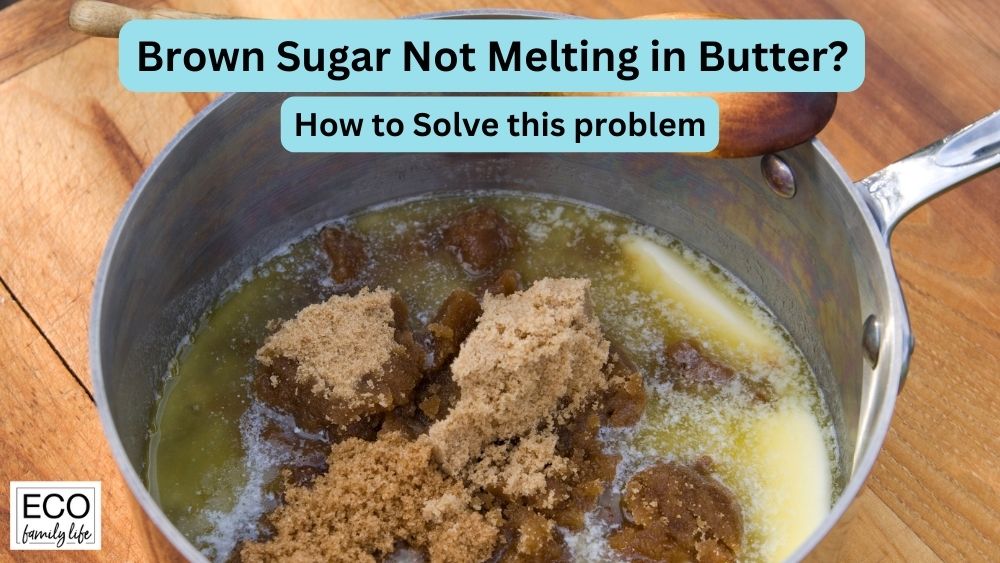Butter might not melt into brown sugar because brown sugar contains molasses, which can cause clumping and make it difficult for the butter to fully incorporate. To ensure that the butter and brown sugar combine properly, it is important to soften the butter to room temperature and to use a mixer or whisk to beat the mixture thoroughly. Another helpful tip is to mix the brown sugar with the butter in small batches, adding a little at a time until all the sugar has been incorporated.
Lots of recipes call for both sugar and butter as ingredients, including cakes and cookies, to name a few. If you’re trying to melt or dissolve the sugar in the butter and it isn’t working, there’s no need to panic. There are other ways you can make sure your butter and brown sugar are blended well, and they are easy solutions.

This article will explore why brown sugar will not melt into butter and why you can do to fix it.
Why Doesn’t Brown Sugar Melt in Butter?
While melting brown sugar into butter is usually easy, it doesn’t always work this way. It’s best to melt the butter first and then add your brown sugar. When the brown sugar doesn’t melt or dissolve like it should, it is usually due to one of three reasons:
- The amount of air pumped into the butter
- The temperature of each of the ingredients
- The type of fat found in the butter
What to Do When This Problem Occurs
If you’re having trouble melting your brown sugar into your butter, there are things you can do to mix the two ingredients better. Here are a few of those things:
1. Make Sure the Butter Is Completely Melted
If your butter isn’t completely melted when you add the brown sugar, dissolving the brown sugar thoroughly becomes a lot more difficult. Heat the butter until it is melted all the way and there are no more “chunks” in it for the best results.
2. Add the Brown Sugar Slowly
After the butter is completely melted, make sure you add the brown sugar slowly, maybe a tablespoon or so at a time. Keep the butter on a low heat as you’re adding the sugar, and make sure you stir the mixture after each addition of sugar.
3. Cube the Butter or Cut It up Into Small Chunks
It is sometimes easier for the butter to melt when it’s in small pieces or cubes. You can add the butter all at once or a few cubes at a time, but you’ll find it much easier to melt completely when there’s a bunch of small pieces as opposed to a few large chunks.
4. Stir Well as the Sugar Is Added
When you’re done adding the sugar to the butter, even if you’re already stirred it after adding each spoonful of sugar, you have to stir the mixture well once again. The more you stir it, the better the mixture will blend together like it should.
5. Soften the Brown Sugar First
Sometimes your brown sugar is so hard that it’s impossible to dissolve regardless of how well the butter is melted. This happens most often when brown sugar is stored improperly. When it happens, place your brown sugar in a microwavable bowl and heat it in the microwave in 15-second increments until it is soft enough to mix well with the butter.
6. Make Sure the Butter Is at Room Temperature
If the butter is too cold, it will either not melt all the way or melt unevenly. Even if the recipe doesn’t state to get the butter at room temperature first, you should still follow this basic rule for the best results.
7. Add a Tiny Bit of Water to the Butter
When you add a small amount of water to the butter before adding the brown sugar, the butter becomes thinner and more liquid-like and therefore, the brown sugar has a much easier time melting. Make sure you don’t add too much liquid – no more than one or two teaspoons of water for every 1/2 cup of butter you’re using.
Things to Keep in Mind
It’s odd to think that you can use the same recipe more than once and get different results sometimes, including when the recipe calls for mixing brown sugar and butter. There are lots of reasons for this, but one of the most common reasons is the fact that the butter you use each time can have different water contents. That water content can vary and directly affects the way the butter and brown sugar mix together.
Another reason might be that your brown sugar is too dry. This can happen if the container you keep the brown sugar in isn’t closed tight enough or when the sugar is simply too old. Water in the butter can also evaporate as you’re melting it, causing the entire mixture to be too dry and therefore difficult to melt the way it should.
Summary
If your brown sugar doesn’t melt in your butter, it could be either the sugar or the butter. Make sure you melt the butter first, add the sugar slowly, and stir well in order to get the right results. These tips and others help ensure the mixture turns out perfectly.
I am an accredited practicing dietitian, experienced gardener and a dedicated cook. I love writing and sharing my experience so you can learn from my successes and mistakes.
